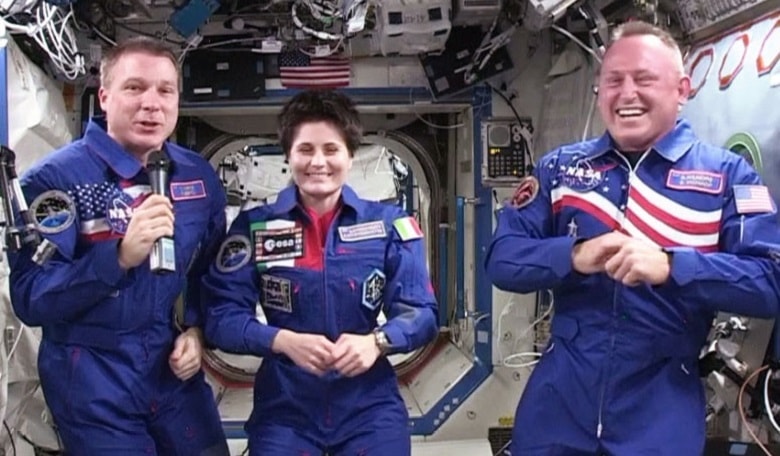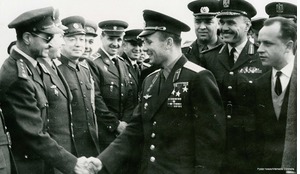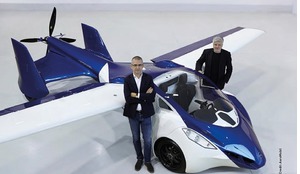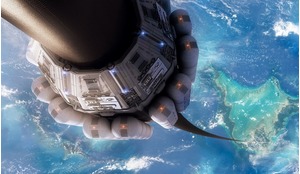My journey started on the night of 23 November 2014. We were sitting on the top of the rocket, and all of a sudden that rocket, like a sleeping animal, woke and lit up the night in the Kazakh steppes surrounding the cosmodrome of Baikonur. The engines started liberating an enormous amount of energy that propelled us on our journey into space. The ride was less than nine minutes and then we were up there in orbit around our home planet, flying around Earth about once every 90 minutes.
My crewmates were Anton Shkaplerov and Terry Virts. It sounds almost like a joke - there was an Italian, an American and a Russian on top of a rocket. But it wasn’t a joke, it was for real! They were the best crew mates I could possibly imagine. Shkaplerov of the Russian Space Agency and Virts from NASA are both veterans of previous space flights.
I’ve dreamt of being part of a spaceship crew since I was a child. We flew up in the Soyuz spacecraft, which small at about 7 m from the front to back. What’s really amazing is that we arrived in space after just nine minutes and then, in this vastness of space, we actually found a place to go. That to me sounds like science fiction - but it’s reality. As human beings we can go to space and we have a destination there. It’s the International Space Station. I like to call it humanity’s outpost in space.
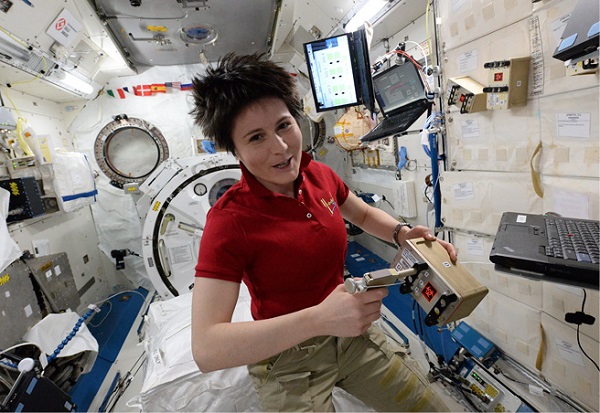 Samantha Cristoforetti
Samantha Cristoforetti
Without any doubt, it is the most amazing feat of engineering ever performed, ever accomplished by humankind. It took about 10 years to build, with efforts from five space agencies, and many countries. The major partners are, of course, the United States and Russia but we at ESA had an important contribution.
So, you get up there, and you find oxygen, air to breathe, you find clothes, you find food, you find water, you find a lot of work. And then you find friends, who open the door to you. When we arrived we were welcomed by other three crewmates, two Russians and an American. And together we formed Expedition 42. And 42, without question, reality or fiction, is the answer to the ultimate question of life, the universe and everything! And our motto was, of course, ‘Don’t panic’.
The Columbus laboratory is our piece of Europe in space. It’s the laboratory of ESA and here we have various items of science equipment for different experiments across a variety of fields that are relevant for research in microgravity, which is, by the way, just a fancy term for ‘weightlessness’.
In space, we get an opportunity and the possibility to carry out scientific experiments under conditions of microgravity, where the effects of gravity are shut down. It’s interesting not only for scientists who do research in human physiology and in life sciences, but also in combustion, materials and fluid science.
So, I spent a lot of my 200 days up there doing research. Much of the time we astronauts are the guinea pigs - the experiments are on us. We periodically take all kinds of samples - blood, urine, and other things I will not go into. The blood samples go in the centrifuge before being placed in a freezer. We have three freezers at minus 94C where we keep the samples until they can hitch a ride back home.
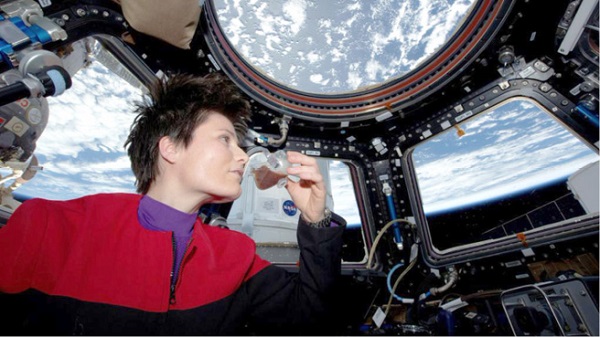 Cristoforetti in Cupola with the famous cup of espresso
Cristoforetti in Cupola with the famous cup of espresso
Sometimes we work on tissue cultures that are put into a little portable container called Kubik (the ESA incubator-centrifuge) which stores them for a set amount of time at a control temperature, to see what happens. For example, I used stem cells to test what happens to the differentiation of stem cells in microgravity. What happens to bones, what if I add a special nano-particle to bone tissue and does that help in preventing bone resorption, which is what leads to osteoporosis and to bone loss for astronauts in space?
For much of the time I worked as a mechanic. The Space Station is a laboratory, of course, and we want to do science but it’s also a very complex machine. So you have to keep it in shape and fix whatever breaks.
Sometimes you even get to build stuff that you can put outside of the Space Station. Now, in science fiction it looks easy, going from inside to outside of the space vehicle. In reality, we’re very careful about that because when you’re opening the door between your nice pressurised area inside and the vacuum of space you really want to be careful.
If something goes wrong - it’s a bad day. We have airlocks. There is a small one in the Japanese laboratory that we can use to move things like equipment from the inside to the outside of the ISS. You install it on the slide table inside, slide it into the airlock, close the door, make a vacuum in the airlock, and then open the door on the other side and slide the table out. And that object, such as a mini-satellite, is now ready to be picked up by the Japanese robotic arm and deployed in its orbit.
Sometimes, if our colleagues bug us, we can actually put them outside! During my stay, there were three EVAs (extra-vehicular activity) or spacewalks, so my colleagues Butch and Terry got to go outside three times. We found that the best way to train for EVAs on Earth is to be in a pool, under water - it’s really the only way we can train for many hours in something like weightlessness and be able to work in three dimensions and in all orientations. So, that’s how we train. In Houston there is a giant pool which contains a full scale replica the Space Station. We train underwater for many hours to do what we would do in space during a spacewalk.
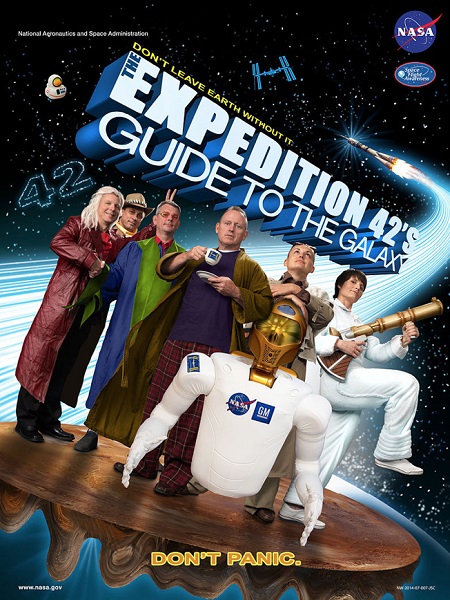 The Expedition 42 crew highlights its link to the ‘Hitchhiker’s Guide to the Galaxy
The Expedition 42 crew highlights its link to the ‘Hitchhiker’s Guide to the Galaxy
But these were stressful days for me too, because when you have two buddies that are going outside into the vacuum of space and you’re responsible for building the space suit piece by piece around them, and you’re responsible for going through the pre-breathe protocol correctly so that they don’t get decompression sickness outside, and you’re responsible for going through all the airlock operations properly to put them out safely and get them safely back inside - it’s a stressful day. Don’t panic! That was our motto! Unfortunately, I did not get to go outside on this mission but hopefully will next time.
One of the things you don’t get to see in science fiction movies (because they’re usually too busy saving the universe) is just normal life, social life and having fun. And that’s very important when you’re up there for 200 days. It’s not like on Earth where you go to work and then go home to your family and friends. In space, your colleagues, your friends and your family are all the same people.
And so it is very important you get along, that you take care of each other, that you make sure you’re attuned to their needs, their moods, and ensure everyone is doing well. Having meals together was a part of our trying to function well as a crew. Celebrating was also important - all three of us had birthdays up there. And we celebrated Christmas twice - our western Christmas on the 25 December and again, two weeks later, for the Orthodox celebration.
In terms of daily life - where do we sleep? Again, it’s not as fancy as it is in some movies. We have a little ‘phone booth’ that’s our own personal space, where we have our laptops, a few personal items and our sleeping bag. When it’s time to sleep we just slide into the sleeping bag. I could just float - float freely. I love to sleep like that.
Exercise in space is important to prevent muscle and bone loss. We are scheduled to work out for two hours every day and have a machine called ARED (Advanced Resistive Exercise Device) that allows you to perform ‘weightlifting’ in weightlessness. You can do squats, dead-lifts, bench-presses and all kinds of typical resistance exercises. And we have a treadmill complete with a harness and strips that keep you pushed down on the treadmill. Otherwise, if you take a step, you’d just float off.
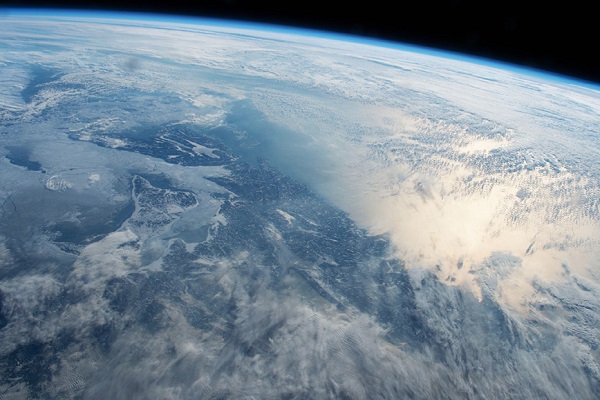 A typical view of Earth from the Space Station’s Cupola, a series of special windows that allow 360 degree views, during Cristoforetti’s mission
A typical view of Earth from the Space Station’s Cupola, a series of special windows that allow 360 degree views, during Cristoforetti’s mission
How about water? We’re human beings and we need water to drink, to rehydrate food (most of our food pouches are dehydrated) and to wash. We don’t have a shower but we can take sponge baths, so we need water for that too.
Obviously, we would not be able to bring water up to the Space Station continually and we can’t just throw away the water we use - so we recycle it. In fact, we recycle everything, including our urine. As we like to say - we turn yesterday’s coffee into tomorrow’s coffee.
Without any doubt, the ISS is the most amazing feat of engineering ever performed, ever accomplished by humankind
And talking about coffee, I got a really nice treat towards the end of the mission - an espresso machine from Italy. So our crew had the privilege of being the first to brew real espresso in space. And they even sent us real zero gravity coffee cups so I could enjoy my coffee in style.
How about food? Well, typically we have dehydrated food or food pouches that we put into the little electric hot oven, warm them up, cut the pouch open, and they’re ready to eat. Kind of like military field rations. But occasionally you will get a bit of fresh food, when they send up a cargo vehicle with supplies. For psychological support we will receive some apples, and maybe tomatoes or carrots that we can eat for a few days. We don’t have any fridges, so we cannot keep them long so we really have to eat them once they come up.
There’s a lot of traffic to and from the Space Station. We had the ESA ATV (Automated Transfer Vehicle), a European resupply vehicle during our expedition. It brought about seven tons of resupplies to us, and the cool thing about it is that it was able to dock completely automatically to the Russian segment.
We also had two Dragons - US vehicles which are a bit smaller but capable of re-entering through the atmosphere without getting destroyed - so they can actually carry items back to Earth. However, they cannot dock automatically to the Space Station so they fly to space and park themselves about 10 m from the ISS, like in a formation flight, and we grab them with the Canadarm2, the Space Station’s big robotic arm. We control the arm from a robotic work station inside, located in the cupola which is every astronaut’s favourite place! We can actually see the robotic arm through the windows of the Cupola.
The Cupola, a European-built dome-like observatory, is every astronaut’s favourite spot on the ISS. It is the place where we watch the sunsets and sunrises, where we take the pictures of our planet that help inspire us to work more closely as nations on the way to making more incredible discoveries in space.





